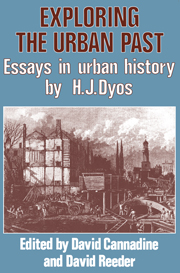Book contents
- Frontmatter
- Contents
- Acknowledgements
- Introduction: H. J. Dyos and the urban process, by David Reeder
- Part One The Urbanising World
- Part Two Transport and Urban Transformation
- 5 The objects of street improvement in Regency and early Victorian London
- 6 Workmen's fares in south London, 1860–1914
- 7 Railways and housing in Victorian London
- 8 Some social costs of railway-building in London
- Part Three The Urban Fabric
- Conclusion Urban history in the United Kingdom: the ‘Dyos phenomenon’ and after, by David Cannadine
- Appendix: A bibliography of the published writings of H. J. Dyos
- Notes
5 - The objects of street improvement in Regency and early Victorian London
Published online by Cambridge University Press: 03 February 2010
- Frontmatter
- Contents
- Acknowledgements
- Introduction: H. J. Dyos and the urban process, by David Reeder
- Part One The Urbanising World
- Part Two Transport and Urban Transformation
- 5 The objects of street improvement in Regency and early Victorian London
- 6 Workmen's fares in south London, 1860–1914
- 7 Railways and housing in Victorian London
- 8 Some social costs of railway-building in London
- Part Three The Urban Fabric
- Conclusion Urban history in the United Kingdom: the ‘Dyos phenomenon’ and after, by David Cannadine
- Appendix: A bibliography of the published writings of H. J. Dyos
- Notes
Summary
The gradual acceptance by politically influential people of the belief that deliberate control of town growth was both feasible and fruitful is a theme in the history of town planning which has many aspects. The transformation of nineteenth-century cities by means of street improvement was one of these; and David Pinkney has recently made a mature assessment of the range of motives underlying the sweeping changes wrought in the configuration of Parisian streets under the Second Empire. By contrast with Paris under the prefecture of Baron Haussmann, the transformation of London was tentative, not to say hesitating, and not undertaken for all the same reasons. In Paris, Pinkney has shown that political and strategic aims were mixed with desires for aesthetic and social amelioration. ‘In London’, Napoleon III is reported as saying, ‘they are concerned only with giving the best possible satisfaction to the needs of traffic.’ But were they? It is the purpose of this brief essay to comment on the validity of this assertion, and in doing so to illustrate an early approach to matters of urban improvement which are still at the heart of some contemporary town-planning problems.
The most dramatic scenic transformation of London before mid-century had occurred in the West End in the cutting of Regent Street after 1814. This was as much the personal triumph of John Nash's indispensable patron, the Prince Regent - later George IV - as it was a consummate display of his own architectural virtuosity.
- Type
- Chapter
- Information
- Exploring the Urban PastEssays in Urban History by H. J. Dyos, pp. 81 - 86Publisher: Cambridge University PressPrint publication year: 1982

